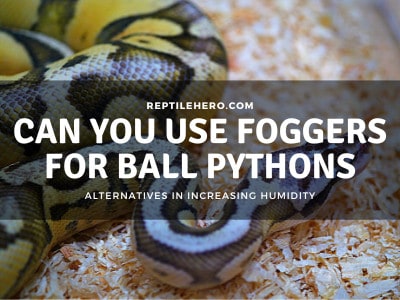Why Did Your Ball Python Attack and Bite You?
One of the main concerns in keeping a ball python is its potential to bite you. Why would they bite us, humans? If you are bitten, will it cause problems for you or the snake? Are there any triggers for a ball python to bite?
In general, ball pythons will bite a human due to a feeding response or a defense mechanism. Biting is not an indication of aggression in ball pythons. Rather, it is a natural reaction to protect themselves against potential threats like humans.
Ball pythons will rarely bite due to their docile temperament. What are the signs of a ball python that is about to strike? What causes defensive behavior in ball pythons? How can you tame down an agitated python? Read until the end to find the answers to all these!
1. Feeding Response
In some cases, ball pythons can mistake a human hand for prey and will attack by striking or biting. Hungry ball pythons will be more receptive to heat signatures and will often assume that it is prey.
A feeding-response bite often happens during and after feeding time. Ball pythons can see your heat signature and may strike you as a mistake.
That is why if a frozen feeder is not warm enough, your ball python might choose to bite you instead.
After feeding time, if you or your hands have a feeder’s scent, it can trigger a ball python to strike.
When feeding ball pythons, I recommend using tongs 10 inches or longer to lessen the chance of getting bitten during feeding time.
Ball pythons can also strike as a feeding response even if it is not their feeding time. If they are hungry, they can even cage-strike if you are near their enclosure.
Warning: Never tease your ball python to strike at the sides of the enclosure. Cage-striking can result in a broken tooth, dislocated jaw, and other injuries on the head.
So if your ball python strikes its cage, it is advisable to stay away or feed it immediately if its eating schedule is near.
2. Defense Mechanism
Even though they are docile, ball pythons will attack or bite to protect themselves. A defensive bite is often accompanied by hissing, puffing-up, and tail wagging.
If a ball python is agitated or feels threatened by you, it may strike. Biting their normal “fight” response while balling up or fleeing is their “flight” response against predators.
Ball pythons can even strike defensively during feeding. If a ball python is full or stressed, it can strike at a feeder but won’t eat.
>>Learn more about ball pythons refusing food in our article about overfeeding ball pythons
If a ball python just strikes and won’t constrict its prey, I recommend checking all the husbandry parameters and feeding it again after 2-3 days.
Fun Fact: Defensive strikes are often just a graze of the ball python’s mouth and it would not latch unto you. Feeding response strikes are more painful and will latch on longer, sometimes even coiling around the bitten area.
What to Do When You’re Bitten by a Ball Python: First Aid!
After getting bit by a ball python, it is recommended to immediately apply first aid by:
- Cleaning the bitten area
- Disinfecting the bite wound
- Placing a wound dressing
- Maintaining treatment until it is dried up
1. Clean the Bitten Area
After a ball python has bitten you, immediately and thoroughly rinse the injured area with clean soap and water [1]. Washing the wound for 5-7 minutes will suffice.
2. Disinfect the Bite Wound
After cleaning the wound, you can dab it with some hydrogen peroxide or alcohol for disinfection. This will be the painful part, but it is necessary to drastically decrease the risk of infection.
3. Place a Wound Dressing
After cleaning and disinfection, apply an antibiotic ointment and finally place a bandaid on the wounded area.
4. Maintain Treatment Until It is Dried Up.
Treat the bite wound with an ointment like Neosporin or Bacitracin until the wound dries up. Ball python bites will rarely cause any sickness or infections once you properly disinfected the wound.
Ball pythons are non-venomous, but can still transmit bacteria through their mouth after biting people.
If the bitten area shows swelling even after thorough disinfection, it is recommended to go to a doctor for treatment.
Warning: If the ball python bite is severe, immediately go to a hospital or doctor.
Large ball pythons have nastier bites and can tear a large chunk of skin which can result in a huge amount of blood loss. Stitches might be the only option in such scenarios.
What to Do if a Ball Python Won’t Let Go While Biting?
If a ball python does not let go while biting, it is recommended to place its head under running cold water or dab alcohol on the corner of its mouth. If none of these work, it is best to wait for it to let go to prevent it from biting down harder.

When using alcohol, you can use a q-tip to release the snake’s bite from you. You can use hand sanitizer or vodka as well, just be careful not to poke its eyes when doing this method.
Warning: Never pull a ball python that has latched on to you. Pulling can cause even more pain and even tear the skin. Doing this can also break the teeth of the ball python which can cause mouth infections.
Even if it is uncomfortable, waiting for a ball python to let go has the risk of causing injury to you and your snake.
4 Signs That a Ball Python is About to Bite
Ball pythons indicate they are about to bite by 1) hissing, 2) tail-wagging, 3) positioning themselves, and 4) being highly receptive.
1. Hissing
One of the main signs that a ball python will bite is through hissing. Snakes create this loud sound by using the air passing in and out of their nose and mouth.
Hissing is the ball python’s defensive sound when it feels threatened. This indicates that it will strike if the threat does not leave it alone.
Hissing is also commonly accompanied by throat inflation, which is done to appear bigger in front of a potential threat.
Fun Fact: Bigger ball pythons have louder and longer hisses compared to smaller ones due to their bigger lungs.
2. Tail-Wagging
Besides mating, ball pythons wag their tail as a defense mechanism against predators. This action indicates that the python is aggressive and will bite when provoked further.
Aggressive ball pythons wag their tails to imitate how rattlesnakes rattle their tails. This is a common mimicry used by non-lethal snakes by copying the behavior of lethal ones [2]. They do this to further ward off predators by pretending to be venomous snakes.
3. Striking Position
A ball python will likely strike and then bite if its neck is at an “S” position while its head is raised. This is the natural striking pose of ball pythons in both defensive and feeding bites.

When you see your ball python in this striking position, be prepared for a possible strike or bite from it.
Proper distancing is a must to avoid getting hit. Stay at least one meter away from a ball python that’s preparing to strike.
Ball pythons use the “S” position to quickly propel themselves to catch prey. A ball python’s strike speed is around 1.5–2.5 meters per second [3].
4. High Receptiveness
Receptive ball pythons strike because they are either hungry or wary of a person’s presence. They will strike because of the heat signature or smell they are sensing.
To know if a ball python is receptive or not, observe if they will follow a live animal like a feeder or simply your hand.
Following a heat signature is often a sign of hunger in ball pythons.
Ball pythons that are threatened instantly flee or go into a defensive stance the moment they detect your presence.
3 Reasons Why Ball Pythons Become Defensive
Ball pythons can become defensive due to stress from 1) unwanted contact, 2) unfamiliar environment, and 3) unexpected disturbance.
There are no truly aggressive ball pythons, only defensive ones. They would not attack humans but instead defend themselves by fighting back or curling into a ball.
1. Unwanted Contact
Improper handling and provocation are prime examples of why ball pythons become defensive. These scenarios will bring them stress which can lead to striking defensively.
When I say improper handling, this includes hard squeezing, constant poking, head-grabbing, and rough handling.
Pro Tip: To implement a more comfortable experience for your ball python, I suggest letting them do what they do while only providing support and light guiding during handling time. This is called choice-based handling.
Also, don’t taunt your ball python by making fast and stressful movements in front of it. They can interpret it as an attack coming which urges them to take a defensive stance.
2. Unfamiliar Environment
A ball python exposed to a new environment will be more cautious thus becoming more defensive. This behavior is normal and done to protect itself in an unfamiliar place.
Imagine you are placed into a new place with most inhabitants significantly bigger than you. What would you do to survive? If your answer is to fight against possible threats, then that is simply why ball pythons become defensive sometimes.
In addition to the stress of being in a new place, a new owner and husbandry parameters (humidity, temperature, etc.) can also make a ball python anxious. So it will be easier to trigger its defensive behavior.
3. Unexpected Disturbance
Disturbing a resting ball python can also trigger a defensive response from it, especially if it is already cage-defensive. It is normal for a ball python to be protective of its territory.
Invading the personal space of a ball python can cause it to become agitated. When they are already provoked inside the cage, they can hiss and wag their tails due to the presence of a potential threat.
How Do You Calm Down a Defensive Ball Python?
Defensive ball pythons can be tamed and calmed down by making them comfortable with being handled. If the snake still tries to bite while being handled, covering it up with a dark fabric can quickly calm it down.
To stop a ball python from striking, you can either pick it up or cover it with a dark fabric/ towel.
Fun Fact: Ball pythons are so docile that if you picked one in the wild, there is only a slim chance of it biting you.
Instead of picking a ball python up slowly, you should carry it confidently in one, fast scoop. Most of the time, ball pythons will become head-shy instead of agitated when picked up.
Ball pythons covered in the dark fabric will feel secure in a short amount of time due to the darkness. This method is done when transferring or cleaning an enclosure of a super defensive ball python.
If your ball python strikes at everything, it might be detecting a faint feeder smell or heat signature. I have also experienced this with my male ball python, Choco when he struck at the spot where there have been mice droppings.
What Does the Bite of a Ball Python Feel Like?
The bite of a ball python feels like being pricked by needles. A ball python bite’s pain will vary depending on the type of bite and the size of the snake.
Defensive striking is less painful compared to a feeding bite. When a ball python defends itself, it does not latch its teeth to the predator but instead just grazes on the surface.
A feeding bite from a ball python can pierce deeply unto the skin which can cause a lot of bleeding. Ball pythons bigger than 500 grams are also reported to have painful feeding response bites.
Fun Fact: Ball pythons have teeth that slope inwards. This type of teeth acts as a “hook” that prevents prey from escaping.
Further Questions
Why is a ball python staring at you?
Ball pythons will stare due to hunger, curiosity, or being wary. There are also times when they are sleeping that make them appear to be staring because they cannot close their eyes.
Do ball pythons attack humans?
Ball pythons do not deliberately attack humans, instead, they defend themselves. They can also view their owners as potential threats which can lead to them becoming more defensive.
How can you make a ball python friendly?
Constant handling from a young age is the best way to make a ball python more friendly. However, some say that they cannot be “friendly.” They can only grow comfortable and trusting in the people they feel safe with.
Summary of Why Your Ball Python Attacks You
Ball pythons will attack and bite humans due to either a feeding response or a defense mechanism. If someone is bitten, it is important to clean the wound, disinfect using alcohol, apply ointment, and put on a band-aid.
If a ball python does not let go from biting, it is recommended to place its head under running water or dab alcohol on its mouth. If a ball python is about to bite, it exhibits hissing, tail-wagging, striking position, and heightened receptiveness.
Unwanted contact, unfamiliar environments, and unexpected disturbances may cause snakes to display defensive behavior. Picking it up confidently and using a dark towel to cover can calm down a ball python.
Sources
[1] https://ufwildlife.ifas.ufl.edu/snakebite_emergency.shtml







